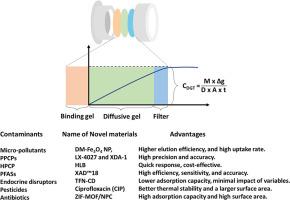Innovative binding gels in diffusive gradients in thin film to detect hazardous contaminants: A critical review
IF 5.4
Q2 ENGINEERING, ENVIRONMENTAL
引用次数: 0
Abstract
This review extensively examines the utilization of diffusive gradients in thin-film (DGT) technology for evaluating hazardous contaminants in terrestrial and aquatic environments. It mainly probes the crucial role of binding gel materials in DGT devices, emphasizing the use of metal–organic frameworks (MOFs), and mixed hybrid nanomaterials in overcoming current challenges and improving DGT device efficiency. Specific types of binding gels are used for monitoring particular classes of contaminants such as DM-Fe3O4 nanoparticles (NP) for heavy metals, and XDA-1 for personal care products, XAD™18 for polyfluoroalkyl substances, TFN-CD for endocrine disruptors, MOF-derived porous carbon materials for antibiotics, ZIF-MOF/UiO-66 for drugs and heavy metals. Compared to traditional binding resins (Chelex®-100, Metsorb™, and ferrihydrite), these hybrid binding gels offer excellent advantages such as high selectivity and sensitivity, improved adsorption capacity, precision, higher elution efficiency, and better recyclability. Thus, these innovative hybrid binding resins are potential candidates for replacing existing binding gels in DGT devices under different environmental conditions.

在薄膜扩散梯度中检测有害污染物的创新型结合凝胶:重要综述
本综述广泛探讨了如何利用薄膜扩散梯度(DGT)技术评估陆地和水生环境中的有害污染物。它主要探讨了结合凝胶材料在 DGT 设备中的关键作用,强调了金属有机框架 (MOF) 和混合杂化纳米材料在克服当前挑战和提高 DGT 设备效率方面的应用。特定类型的结合凝胶用于监测特定类别的污染物,如 DM-Fe3O4 纳米颗粒 (NP) 用于监测重金属,XDA-1 用于监测个人护理产品,XAD™18 用于监测多氟烷基物质,TFN-CD 用于监测内分泌干扰物,MOF 衍生的多孔碳材料用于监测抗生素,ZIF-MOF/UiO-66 用于监测药物和重金属。与传统的结合树脂(Chelex®-100、Metsorb™ 和铁酸盐)相比,这些混合结合凝胶具有选择性高、灵敏度高、吸附容量大、吸附精度高、洗脱效率高和可回收性好等优点。因此,这些创新的混合结合树脂是在不同环境条件下替代 DGT 设备中现有结合凝胶的潜在候选材料。
本文章由计算机程序翻译,如有差异,请以英文原文为准。
求助全文
约1分钟内获得全文
求助全文
来源期刊

Journal of hazardous materials advances
Environmental Engineering
CiteScore
4.80
自引率
0.00%
发文量
0
审稿时长
50 days
 求助内容:
求助内容: 应助结果提醒方式:
应助结果提醒方式:


